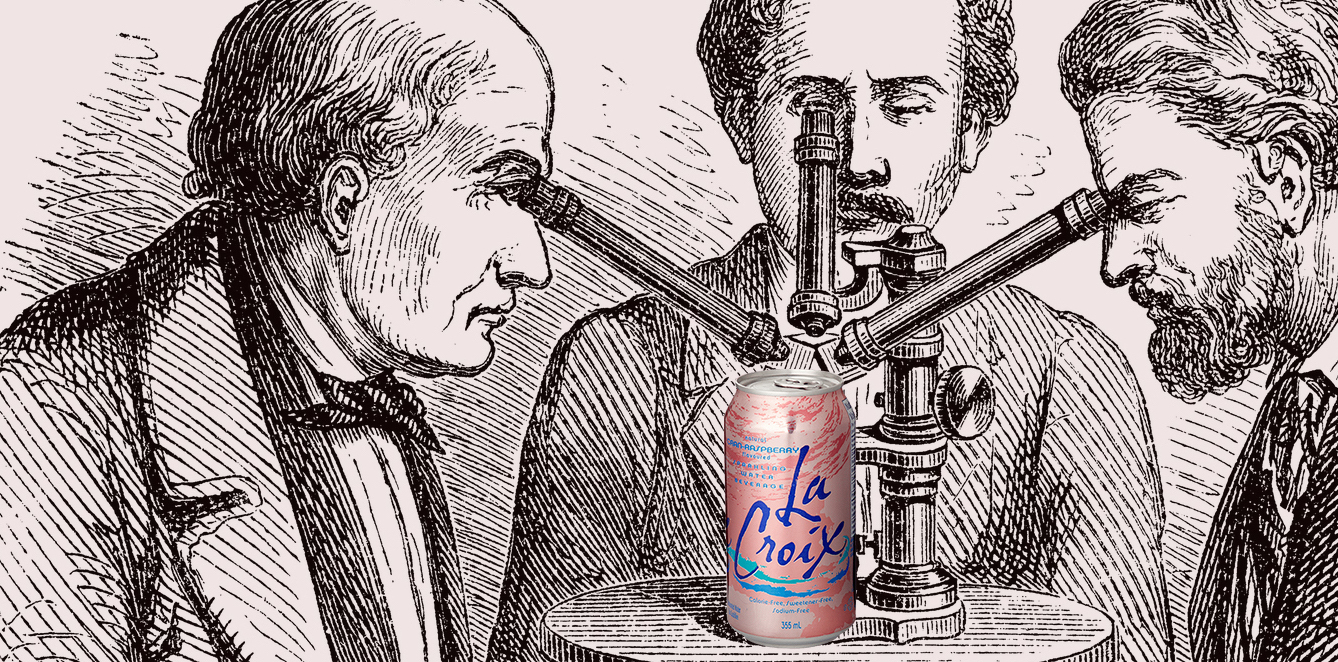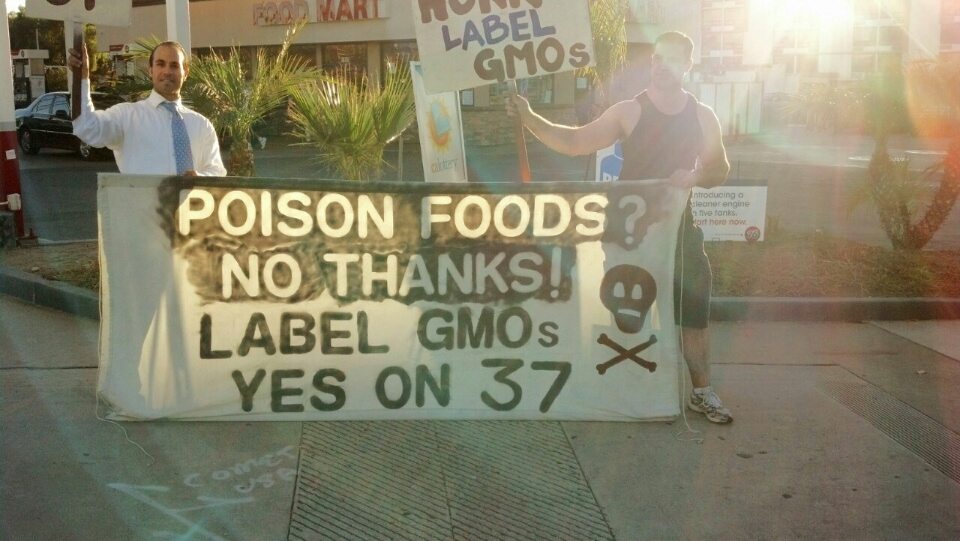
Photos by iStock / ilbusca and Lacroix, graphic by NFE
Based on how October is shaping up, the scariest costume this Halloween might just be “flavor chemical.”
First, a class-action lawsuit filed in Chicago by Beaumont Costales accused the Natural Beverage Corporation, makers of LaCroix, of deceiving consumers by using “artificial chemicals” in its supposedly “100% natural” flavored fizzy waters. Although all the chemicals mentioned in the lawsuit are naturally occurring, found in common citrus fruits and herbs, and widely recognized as safe, the plaintiffs raised the specter of fear by associating them with cancer drugs, kidney tumors, and “cockroach insecticide.”
Then, on October 5, the Food and Drug Administration (FDA) announced it was taking the rare step of amending its regulations to remove six synthetic flavor chemicals from its list of approved food additives. This action came in response to a food additive petition, originally filed in 2016 by a coalition of eight consumer, environment, and public health NGOs. The petition claimed that the chemicals were known carcinogens and should be banned from the food supply.
The activist coalition—which included the Center for Science in the Public Interest (CSPI), the National Resources Defense Council (NRDC), the Environmental Defense Fund (EDF), and other heavy-hitters—was quick to claim victory for consumer health and safety, but the actual language of FDA’s ruling was murkier. While revoking its approval for these synthetic additives, FDA nonetheless insisted that they were “safe for human consumption” and “unlikely to pose a potential or significant carcinogenic risk for humans.”
You’ve most likely never heard of any of the six substances named in the FDA decision: benzophenone, ethyl acrylate, methyl eugenol, myrcene, pulegone, and pyridine. (A seventh chemical mentioned in the petition, styrene, is no longer used by the flavor industry, so FDA declared that portion of the request moot.) Yet they are not by any means new to the food supply. These synthetic compounds have been approved as food additives since 1964, and some have been in use for decades longer than that, in flavorings for ice cream, baked goods, candy, and other foods.
All of these chemicals are also found naturally in familiar foods. When you eat a grape, you’re consuming benzophenone. Methyl eugenol is present in a large number of plants, including basil. Myrcene is a component of citrus oils, thyme, and hops, to name just a few natural sources; it’s also a common terpene in cannabis. If you’ve eaten pineapple or peppermint, or if you drink coffee, you’ve come in contact with some of the other chemicals named in this petition.
In most cases, we are exposed to far higher levels of these substances from natural sources in the food supply than from synthetic additives. Take pulegone, a flavor chemical that contributes to the minty-ness of peppermint. According to data cited by FDA, 13 pounds of synthetic pulegone are manufactured every year for use in flavorings. In contrast, the amount of pulegone from natural sources in the food supply (like mint, for example) is estimated at 1,900 pounds a year—nearly 150 times as much.
The evidence that these substances might cause cancer comes from National Toxicology Program (NTP), a sister agency of FDA, and was obtained using widely accepted scientific guidelines for evaluating carcinogenicity. In these studies, mice and rats were given large doses of these chemicals—orders of magnitude larger than any likely human exposure—and then surveilled for tumors. None of the testing used human subjects, and there are no known cases of cancer in humans associated with any of these chemicals. Indeed, FDA concludes that “none of the data… supports a finding that [these six synthetic substances] are human carcinogens when consumed at the levels of intended use.”
 .
. Graphic by The New Food Economy
Whether or not you agree with this conclusion, FDA’s decision only applies to synthetic forms of these chemicals. So even if we don’t consume these chemicals as food additives, we’ll still be ingesting them in foods.
In an absolute sense, it would be difficult to argue that this decision will make American eaters any safer. So how should we make sense of its meaning?
The 60-year-old food additives law
In order to understand the coalition’s petition, and FDA’s response to it, we have to turn back the clock 60 years to the law that continues to serve as a cornerstone of food safety regulation in the United States: the 1958 Food Additives Amendment.
In the 1950s, legislators were confronting a food system that was being transformed by synthetic chemistry. Advances in post-war food technology brought an explosion of new chemical additives, making possible many of the supermarket innovations of the time: the fluffiness of Wonder Bread, the extended shelf-life of potato chips, and a kaleidoscope of alluring flavors in beverages, snacks, and other treats. The problem was that FDA had no effective way of ensuring the safety of these chemicals before they reached our plates. Existing law, the 1938 Food, Drugs, & Cosmetics Act, only gave the federal government the power to act after the fact—to issue a recall only if and when a food additive had been shown to cause harm.
The Food Additives Amendment changed the rules of the game entirely. It gave FDA pre-market approval over food additives—the same kind of authority the agency already had to regulate pharmaceuticals. Manufacturers were required to submit scientific evidence showing, in the words of the statute, “reasonable certainty in the minds of competent scientists that the substance is not harmful under intended conditions of use.” For the first time, the food industry had to prove to FDA that a synthetic chemical presented negligible danger to human health before it could be used in food.
This was an absolute prohibition, and a departure from the language about “reasonable certainty” and “intended conditions of use” elsewhere in the statute. A toxicological maxim is that “the dose makes the poison,” meaning no substance is inherently harmful; it becomes a “poison” only after it exceeds a certain biological threshold. Assessing a chemical’s safety typically meant determining that threshold, ascertaining how the substance was to be used in foods (its “intended conditions of use”), and ensuring that a person’s intake through eating or drinking was not likely to come anywhere close to the danger level.
But the Delaney Clause dictated that, in the case of potential carcinogens, there was no threshold; there were no margins of safety. Any evidence of cancer, at any dose, in animal testing would be enough to prohibit a chemical additive from the human food supply. If the “reasonable certainty of no harm” standard was about managing and minimizing risk, the Delaney Clause sought to eliminate hazard entirely. In other words, these are two competing meanings of “safety.”
The science of safety
This divergence explains what might otherwise seem like double-talk from the agency in its response to the NGOs’ petition. When FDA writes that it has “a reasonable certainty that the [six synthetic] substances do no harm under the intended conditions of use,” it is applying the broader food additive safety standard to the chemicals in question. Yet when the agency then goes on to say that it nonetheless “cannot consider these flavoring substances to be safe as a matter of law,” it means its actions are governed by the Delaney Clause because these substances have been implicated in cancer.
As the trade organization for the flavor industry, FEMA could be accused of having an interest in opposing stricter rules. Yet its criticism of the Delaney Clause is hardly unique, and is echoed by many scientists and regulators. Still, it remains the law of the land, and Congressional efforts to revise or revoke the clause have not been successful.
For the advocates who brought the petition, the Delaney Clause is a powerful tool for protecting public health and consumer safety. Thomas Neltner, chemicals policy director at EDF and one of the architects of the petition, praises the law’s unambiguous mandate to protect consumers from potentially harmful chemicals. “Congress said to the FDA, you have the responsibility to protect consumers from carcinogens,” he says. The law, he continues, is “crystal clear. If it causes cancer in man or animal, you don’t intentionally add it to food.”
Dr. Maricel Maffini, a biologist who served as a consulting senior scientist in this effort, says that this petition was about making sure regulations reflect the most recent science.
“We don’t have a system in place to re-evaluate the safety of additives,” Maffini points out. We now know more about these substances than when they were originally green-lit as safe in the 1960s. “Science is an evolving matter, science changes—and now there is good evidence that these chemicals should be classified as carcinogens.”
In the 1950s, advances in post-war food technology boomed, bringing about supermarket innovations like the fluffiness of Wonder Bread
I ask her about FDA’s response to the petition, which, while it endorses the validity of the animal tests conducted by the NTP, nonetheless repeatedly questions how applicable these results are to assessing cancer risk in humans. (An example of the potential for biologically incompatible results can be found in the NTP study of ethyl acrylate, which found that rats exposed to the chemical had a greater risk of of developing tumors on their forestomach. Rats have two stomachs, the first being a holding chamber for food that’s just been swallowed. Humans, of course, do not.)
Maffini insists that the fundamental biological finding—the evidence of carcinogenic potential—is too significant to dismiss. “A tumor is a tumor,” she says.
If that’s the case, I ask, should a person who is trying to minimize their exposure to carcinogenic substances avoid foods containing naturally-occurring forms of these chemicals? For instance, should consumers eschew basil for its methyl eugenol content, coffee for its pyridine, or pineapple for its ethyl acrylate?
Maffini tells me that purified, synthetic substances may pose unique risks that their natural counterparts do not. As an example, she points to research cited by FDA indicating that the toxicity of methyl eugenol may be mitigated by other chemical compounds in basil extract. “A chemical in isolation could have different effects than when it is part of a mixture, as in a food,” she says. In other words, the contexts in which synthetics are used may confer additional hazards.
Flavor chemists, who work directly with both synthetic and naturally derived forms of flavor molecules, take issue with that claim. “A molecule is a molecule,” says Mike Fasano, a recently retired flavor chemist. “The fact that the sourcing, or the process, is different—the end point is the same.” Flavor chemists like Fasano work with purified substances “because impurities are going to affect other things, like the flavor or stability of the foodstuff,” but consumers rarely, if ever, encounter these chemicals in isolation. They are always a part of a mixture.
Just as synthetic shouldn’t automatically imply danger, natural doesn’t mean harmless. “Cabbage contains 50 mutagens and carcinogens,” Clemens tells me. “If man had put those mutagens and carcinogens in the food supply, cabbage would not be on the market.” But don’t let that stop you from enjoying your choucroute. “People should understand that many foods contain naturally-occuring toxins, but usually in such small quantities it has no impact on health outcome,” he says.
The politics of regulation
Ultimately, the coalition’s petition is not only about science. It’s also about politics. As such, it’s the latest development in an ingenious legal strategy aimed at encouraging FDA to assume a more active role in regulating the safety of chemical additives.
For decades, the food additive petition process was exclusively used by industry to efficiently secure FDA approval for new food chemicals. Then, in the 2010s, a group of researchers and activists—including Neltner and Maffini, among others—realized that the process could also be used to revoke approval. By filing a food additive petition and a follow-up lawsuit, earlier this year, to require FDA to reach a decision, the NGOs have effectively forced the agency’s hand.
This is not the first time the strategy has paid dividends. In 2016, FDA rescinded its approval of several long-chain perfluorinated compounds (PFCs)—polymers used in packaging, like pizza boxes, to help prevent sticking and stains. Other open food additive petitions, challenging the use of perchlorates and ortho-phthalates in food packaging and manufacturing, remain unresolved.
MacCleery and others hope to provoke FDA to more aggressively evaluate the safety of chemical additives. Flavor chemicals have long enjoyed a special regulatory arrangement, brokered by FEMA, the flavor industry trade group, in the wake of the 1958 Food Additives Amendment. This has largely allowed these materials to avoid direct FDA oversight.
Under this system, FEMA convenes a group of well-qualified experts to conduct a scientific review of different flavor chemicals and determine whether they are “generally recognized as safe”—GRAS—and thus exempt from the FDA food additive approval process. Every two years, a new list of GRAS flavor chemicals is published. These experts also periodically re-evaluate previously approved substances, revoking GRAS status if appropriate. Methyl eugenol, for example, was recently removed from the GRAS list pending additional review of its safety, pre-dating this federal action.
For the flavor industry, the GRAS expert review system represents a necessary compromise between the needs of industry and the limited resources of the federal government, an efficient way of assuring safety for a class of chemicals that are typically used at low enough levels that risk can be assumed to be negligible. For certain public health activists, however, GRAS is a “loophole” that allows companies to introduce new chemicals to the food supply without adequate review, based on the say-so of industry-linked scientists.
Among other qualities, chemical additives give potato chips their extended shelf-life. Will we taste food differently without them?
This month’s flavor additive decision from FDA does not have any direct repercussions on the GRAS system. But it’s clear that FEMA’s GRAS program is in activists’ sights. “By my count, NTP studies have identified six more flavoring materials [currently on the GRAS list] as carcinogenic,” Neltner says. “But when you’re trying to fix a mess that’s been created by 50 years of neglect, you have to set your priorities.”
Will we taste the difference?
The FDA’s decision is expected to have minimal consequences for food and flavor manufacturers, which in any case will have until 2020 to comply with the rule change. “These materials are used at very low amounts by the flavor industry, and thus the impact to industry is small,” a FEMA representative told me in an email.
Neltner agrees. “Remember, there are something like 2,700 flavor chemicals,” he says, many of them with substantially similar qualities.
Just as the disappearance of these synthetic chemicals will likely have negligible health consequences, few of us will be able to detect their absence in the flavorings used in our food.
But how will it affect the people who work most closely with these chemicals, the flavorists and flavor chemists who use them to formulate flavors? I ask Dennis Kucharczyk, a retired flavor chemist who spent more than 40 years in the industry, to walk me through how he might use the substances affected by this decision. Some of them, like benzophene, he’s never worked with. Others—pyridine (“kind of a nutty, bloody, dirty note”) and myrcene (“smells like pot, you know, marijuana; kind of a vegetative earthy green, I’ve actually used it in carrots, but it has solubility problems and oxidizes, so it’s kind of a pain in the ass to use”)—he considers less than critical.
Kucharczyk urges me not to take his judgments on the utility of these compounds as definitive. “If you ask five different flavor chemists, they’re going to give you five different answers,” he says.
For flavorists like Kucharczyk and Mike Fasano, of larger concern is the broader atmosphere of misunderstanding and mistrust around their work and the materials they work with.
Fasano says he has sometimes faced hostility when he tells people what he does for a living. “’Oh, you’re the one whose putting that poison in food and killing my children.’ I’ve had people say that to my face,” he tells me. He assures me he does not take health risks lightly; he is himself a cancer survivor. “More than anybody else, we are aware of the ramifications of these materials,” he says.
But he is frustrated by what he believes to be the widespread, indiscriminate fear about “chemicals” in the food supply. “If it’s not e=mc2, if it’s not pure energy, it’s a chemical,” Fasano says. “All food is chemicals.”
Managing the fear factor
All sides can agree on one thing, at least. Eaters are confused and scared, increasingly freaked out about the chemicals in foods, and neither federal regulators nor private industry are doing an adequate job of assuaging those concerns.
“There’s a crisis in consumer confidence,” says MacCleery, of CSPI. She attributes this to FDA’s failure to fulfill its obligations to regulate additives and contaminants in the food supply. “When consumers fail to have faith in an objective regulator,” she says, “one that is protecting their health and translating the science in a compelling way, everything becomes chaotic.”
This is the kind of environment that breeds lawsuits like the one against LaCroix, with its misleading assertions. It’s also an expensive problem for companies, which undertake costly “clean label” reformulations that often have minimal benefits for consumers. “They are taking stabs in the dark, removing ingredients that sound ‘chemical’ but might be safe, without the structure that would be provided by an objective public regulator,” MacCleery observes.
For MacCleery and her colleagues, the goal is not to defeat chemical additives or the companies that make or use them, but to build a more rational and orderly system to protect health and enforce accountability. She points to the example of artificial trans fats, which FDA ruled unsafe in 2015 and officially banned earlier this year, as an example of a success story.
“When the FDA said, you can’t use these, these are not safe, industry organized itself,” and found solutions. The goal is to get the industry in agreement with the FDA and the non-profit health sector, “around a shared set of public health goals that actually, rationally advances health. That’s what we have an urgent need for right now.”
Correction: An earlier version of this story quoted Thomas Neltner, chemicals policy director at EDF, as having said: “By my count, NTP studies have identified 17 more flavoring materials [currently on the GRAS list] as carcinogenic …” Neltner has since revised that number to reflect an error in calculation. In fact, NTP has reviewed 17 chemicals from the FEMA GRAS LIST, six of which have shown evidence of carcinogenic potential. We have corrected the error in the text.












